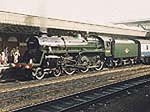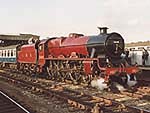|
17th
April 1982: I had three runs on the Welsh Marches with 92220
"Evening Star". Two were dreadful, but this one excellent.
With a heavy 450/475 ton load, we followed a "Footex" from
Shrewsbury and were immediately checked. Then followed a p.w.slack at
Bayston Hill, after which "Evening Star" was well and truly
opened up. 55 mph at Dorrington, and 41 mph at Church Stretton summit.
Thereafter some brisk running, 68 mph max, on to Hereford.
[view
log of 92220]
23rd and 31st October, 6th November
1982: 46229 came south on 23rd October 1982, and worked Chester to
Shrewsbury with some panache. With a 525 ton load, nothing lower than 42
mph on Gresford bank was excellent. Then a 76 mph at Baschurch,
and we knew the "Duchess" had arrived. On the 31st, she worked
north from Newport, with good climbs up to Pontypool Road (38 mph at
Panteg), and to Llanvihangel (41 mph). She returned north on 6th
November, working Hereford to Shrewsbury and Chester. Up to Church
Stretton she was worked easily, 31 mph at the summit, and it was after
the Baschurch water stop that the best running occurred, with 73 mph at
Whitehurst, and 71 mph at Pulford. [view log of
46229]
19th
and 26th February 1983: On the 19th February this potent Severn Valley loco pairing was on the "Top
leg" from Shrewsbury to Hereford. A good climb to Church Stretton,
37 mph, was the best feature. Thereafter running was restrained
on an inflated schedule, though we did reach 69
mph at Dinmore. It was on the 26th February, on the Hereford to Newport
leg, and the return, that the fireworks began. Superb hill climbing, Llanvihangel
taken southbound at 43 mph, and northbound at 38mph, was matched by some
"brisk" running elsewhere. The Pempergwm curve was taken at
73/74 mph southbound, and 76 mph northbound. After
some vigorous run pasts at Abergavenny, we were 18 mins early back into Hereford.
A serious contender for the "Most exciting run of the 1980s". [view
log of 80079 and 43106]
|
|
|
2nd March
1985: I believe that this was 75069's inaugural main line run. And what a fine
job she made of it. Brisk running from Newport up the Severn Estuary, then a
good climb up to Sapperton Tunnel, at least until she slipped. Then a 69 mph
running back in to Gloucester. A certain "BR Official" was not keen
on class 4's on the main line. "Couldn't pull the skin off a rice
pudding", he was heard to say. He soon learned otherwise. The loco proved
an excellent performer, as did sister 75014. [view log of
75069]
27th
July 1985: With a class 4 plus 9 combination on a 9 coach train, no hard
work was required. The interest lay in the loco combination. Had there
previously been a pairing of a 75 and 92, and has it happened
since. I suspect the answer is "no" to both questions. An
added interest was that we were permitted to travel with steam from
Gloucester to Abbotswood Junction and Worcester. There were two 69 mph's
on the Newport to Gloucester section, and later, a 71 mph below Cleeve. [view
log of 75069 and 92220]
31st
May 1986: Two of my favourite locomotives on the return leg of the
Swindon to Hereford then back to Gloucester "double heading"
extravaganza, which also involved 5051 and 6998 from Didcot. 75069 and
5690 (the latter being subject to Bridge Slacks) ran well uphill out of
Hereford and again up to Llanvihangel (42 mph). 71 mph was reached at
Abergavenny Junction. More brisk running followed on the Newport to
Gloucester section. [view
log of 75069 and 5690]
29th May 2000: All
was not well with 60532 on this tour. We started from Chester well
enough, 36 mph up Gresford bank. After the water stop at Chirk, poor
track quality dictated slow running to Shrewsbury. Then a disappointing
climb to Church Stretton, 31 mph, was followed by brisk running down
through Onibury. Then a severe easing, 44 mph over the Woofferton
"hump", when we should have been doing 60 or so. Presumably
steaming problems. After the Hereford stop things improved, with a good
climb to Llanvihangel. But overall, a disappointing day. [view
log of 60532]
|
|

